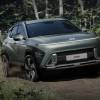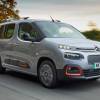
RAC sale – up to 33% off*
• Roadside cover from £5.29 a month†
• We get to most breakdowns in 60 mins or less
• Our patrols fix 4/5 breakdowns on the spot

By Jonathan Crouch
Introduction
A little surprisingly, there weren't many full-hybrid small SUV crossovers on the market between 2019 and 2023 - just conventional models, mild hybrids and full-electric contenders. But back at the end of the 21st century's second decade, Hyundai noted the success that Toyota's C-HR was having in providing a full-hybrid option in this segment and in response, used the engineering first seen in the first generation Kia Niro to bring us this Kona Hybrid model.
Models
5dr SUV [1.6 GDi Hybrid]
History
The Kona small SUV, named after the island of Hawaii's Kona district, proved to be one of Hyundai's strongest-selling models at the end of the 21st century's second decade. It was first launched in 2017 with a range of petrol and diesel engines, but the diesel was effectively replaced in 2019 by the Kona Hybrid variant we look at here, a petrol/electric derivative using much of the engineering already seen in the company's frugally-focused IONIQ model.
We ought to clarify the terminology here. 'Hybrid' is a word bandied about quite a bit these days, but very often in this class it designates 'mild hybrid' technology, the sort of thing offered in this sector in this period in, say, a Ford Puma, which sees a normal combustion engine only very marginally electrified by a tiny battery positioned under the rear seat. Full-Hybrid engines are very different and, unlike mild hybrids, can switch to full-electrification in city motoring. Back in 2019, Toyota's C-HR and Kia's Niro were the only other models currently offering such a thing in the small SUV segment.
The Kona Hybrid got a mild facelift in 2021, which brought a general smartening up of the styling. And a much enhanced level of media tech inside. A new MK2 Kona Hybrid design arrived in mid-2023.
What You Get
It's difficult to distinguish a Kona Hybrid from a conventional petrol model, but brand loyalists will perhaps note 16-inch wheels of a design bespoke to the hybrid model and the special 'Blue Drive' badging used on the wings and tailgate.
Inside, there's a cabin distinguished in this hybrid model by white accents around the air vents and gear lever surround, as well as accompanying white stitching to the seats. The pre-facelift base 'SE' model gets a 7-inch centre-dash touchscreen but further up the range, that's replaced by a larger, more sophisticated 10.25-inch monitor. Through the wheel, the instrument cluster's slightly different, as you'd expect it would be in a full-hybrid model, the left hand gauge replaced by a dial with blue 'Charge', green 'ECO' and white 'Power' sections. You can also bring up an informative energy flow meter to display between the gauges which shows you at any given time what's being powered by or charging what.
What about rear seat space? Well as it turns out, by the modest standards of the small SUV segment, it's not too bad in the back for the carriage of two folk, providing they're not especially lanky of leg. Out back, there's a 361-litre boot that's the same size as that of the ordinary petrol model. You can extend it in size to 1,143-litres when the 60:40 split-folding rear backrest is flattened.
What You Pay
Please fill in the form here for an exact up-to-date information.
What to Look For
Generally, most Kona customers seemed very happy with their cars. However, in our ownership survey, we came across a number of issues. One owner advised potential future buyers to always take a test drive at night to check the headlights. The non-LED ones are dim and yellow. Also, moisture can accumulate in the non-LED headlights, plus in the daytime running lights, the fog lamps and the rear combination lamps. Another owner reported that when driving at over 40mph, the vehicle wandered to the left and right without driver input. Another owner had an issue with faulty vehicle speed control with an auto model - the vehicle inexplicably lurched forward when parking and the airbag activated.
Other owners reported rubbing and grating noises from behind the wheel; look out for those on your test drive. A gear in the steering system may be the cause. There have also been reported issues with the blind spot collision warning system cutting down, the BlueLink media set-up not working correctly, the cruise control not operating properly and the forward collision warning system disabling itself during use.
Otherwise, it's just the usual things for an SUV of this type. Check all the media tech on your test drive - and the workings of the navigation system to see if it's been kept up to date. Check the touchscreens and Bluetooth connectivity. Check the upholstery for cuts and stains. And inspect the alloy wheels for kerbing damage. Check all the electrical functions too. And insist on a fully stamped-up service history.
Replacement Parts
(approx based on a 2021 Kona Hybrid 1.6 GDi - Ex Vat) Front brake pads sit in the £22 bracket; rear pad sets are around £32. Front brake discs sit in the £75 bracket; rear discs are around £37. A pollen filter is around £9-£14. A pollen filter is around £18-£21. A wiper blade is in the £8-£26 bracket. An oil filter is around £8.
On the Road
The Kona Hybrid took its drivetrain from the proven IONIQ Hybrid, using a Kappa 1.6 GDi Atkinson Cycle combustion engine working with a 1.56kWh battery and a 32kW motor to deliver a maximum hybrid system power of 141PS and 265Nm to the front wheels, via a 6 speed dual clutch transmission. That torque output wasn't quite as much as was generated by the diesel version being replaced by this car, but it wasn't too far off. This model's little electric motor draws its energy from a lithium-ion polymer battery, but it's only 1.56kWh in size, so definitely not of the plug-in variety. As for performance, well 62mph from rest takes 11.6s en route to a 115mph maximum.
This electrified Kona model took its more sophisticated multi-link rear suspension from the top variant in the original pre-facelift petrol Kona range, the 1.6-litre 'Premium GT' derivative. And it can offer a towing capacity of up to 1300kg. On the move, you notice a somewhat rough, coarse note to the GDI petrol engine under harsh acceleration - it's one of Hyundai's older units. But lift off and refinement reigns supreme, perfectly complementing the light but accurate 'Motor Driven Power Steering' system that makes the car so easy to precisely place on the road, whether you're in town or threading your way at speed through corners on the open road. To improve traction and damping through those bends, there's also an 'Advanced Traction Cornering Control' package. Plus there's a 'Sport' mode to sharpen throttle response and give the steering a little more weight.
Overall
If you're after a small Crossover from the 2019-2023 period that's particularly city-orientated and you're not quite ready to take the plunge into full-EV motoring, then this Kona Hybrid might prove to be a very good pick. This variant didn't of course garner as many headlines as the fully battery-powered Kona Electric but in reality, it's probably the better used pick for the majority of likely buyers.
Obviously the key competitor from period here is the Toyota C-HR. Well that car represents tough opposition but there's certainly plenty of room in the full-Hybrid part of this class for both cars and this Kona represents a slightly better value proposition.







